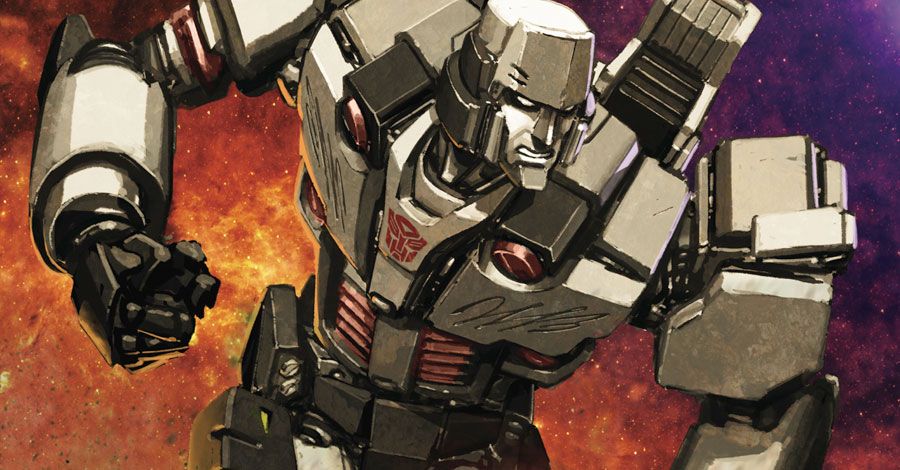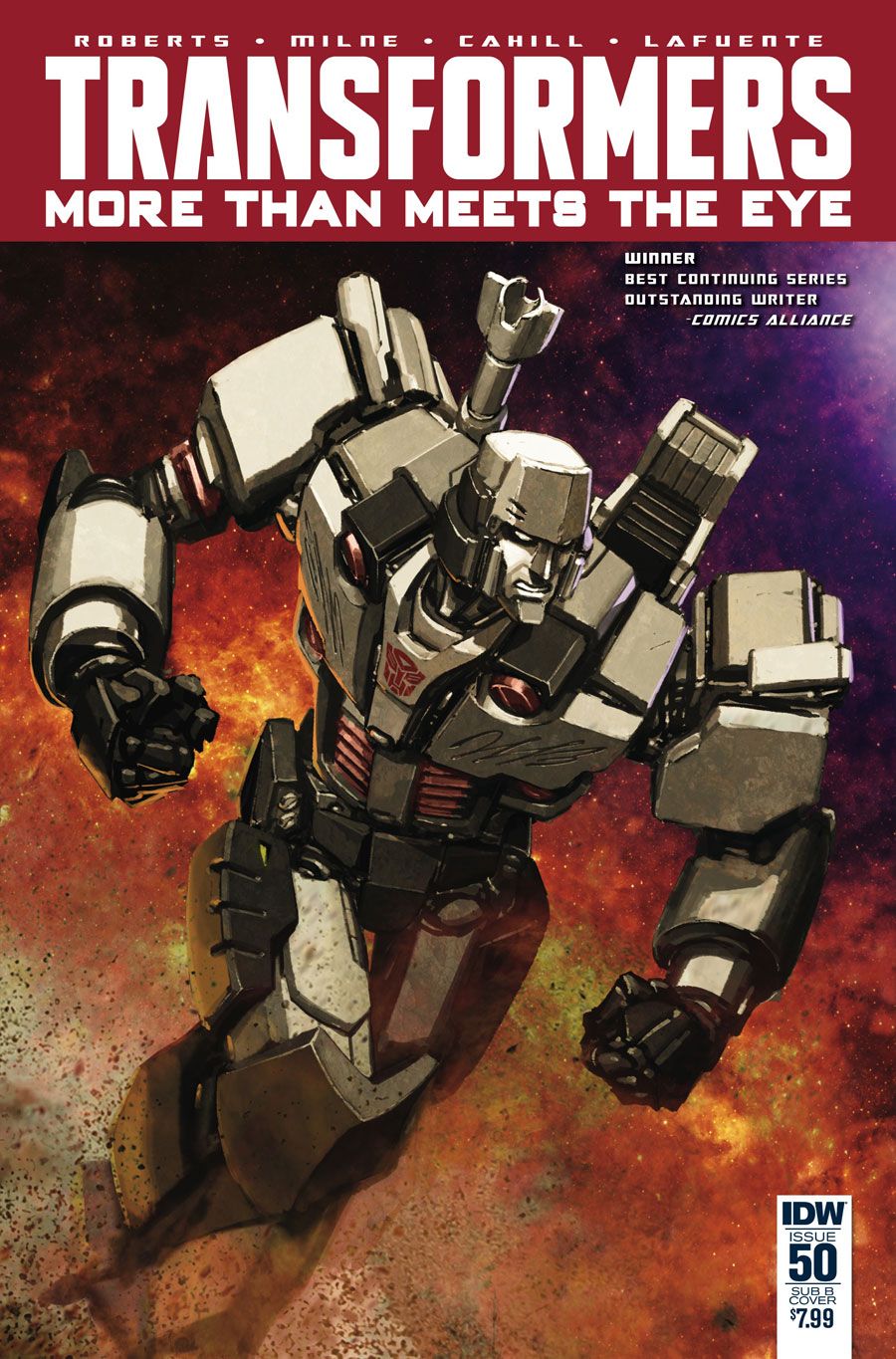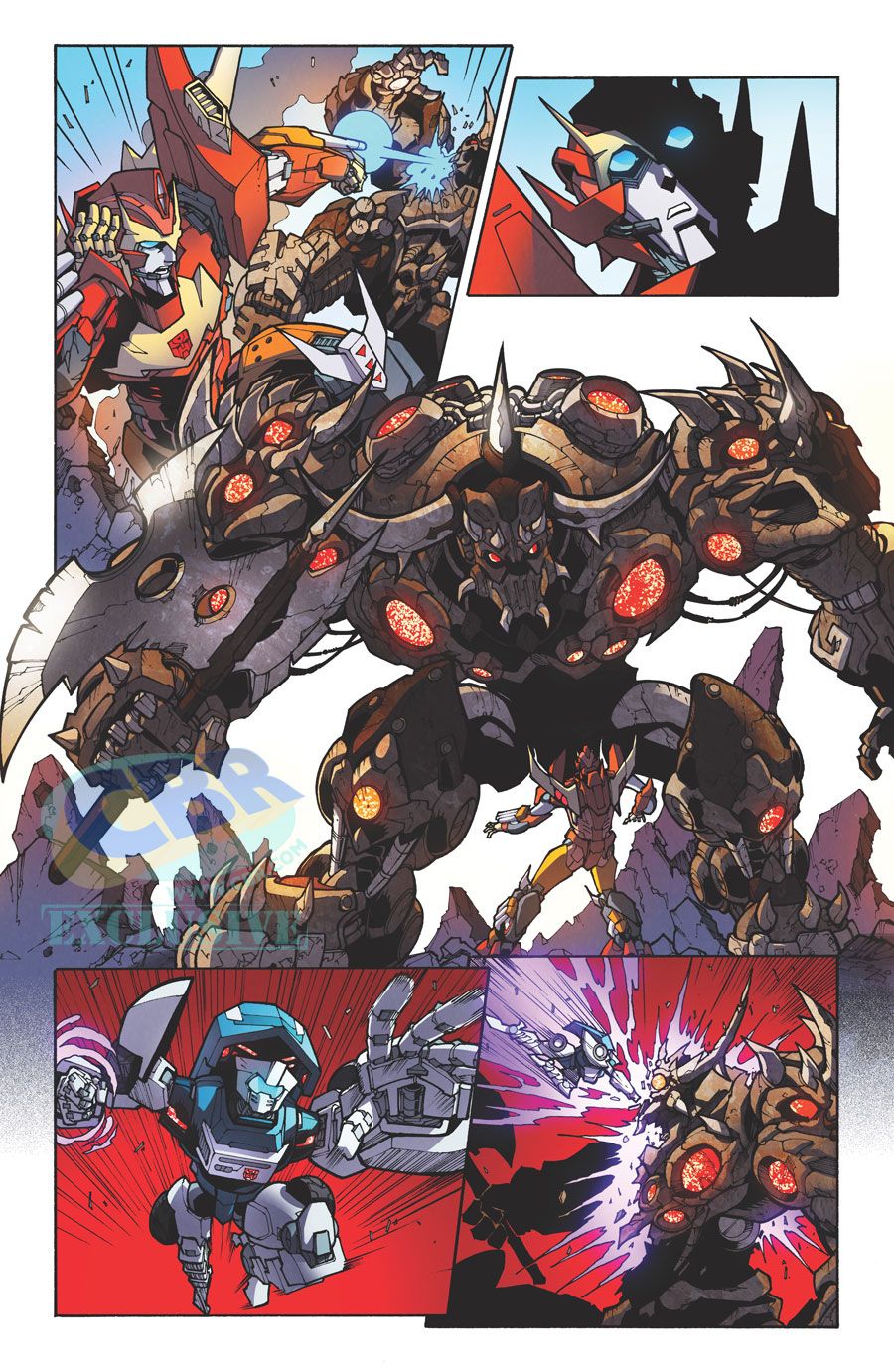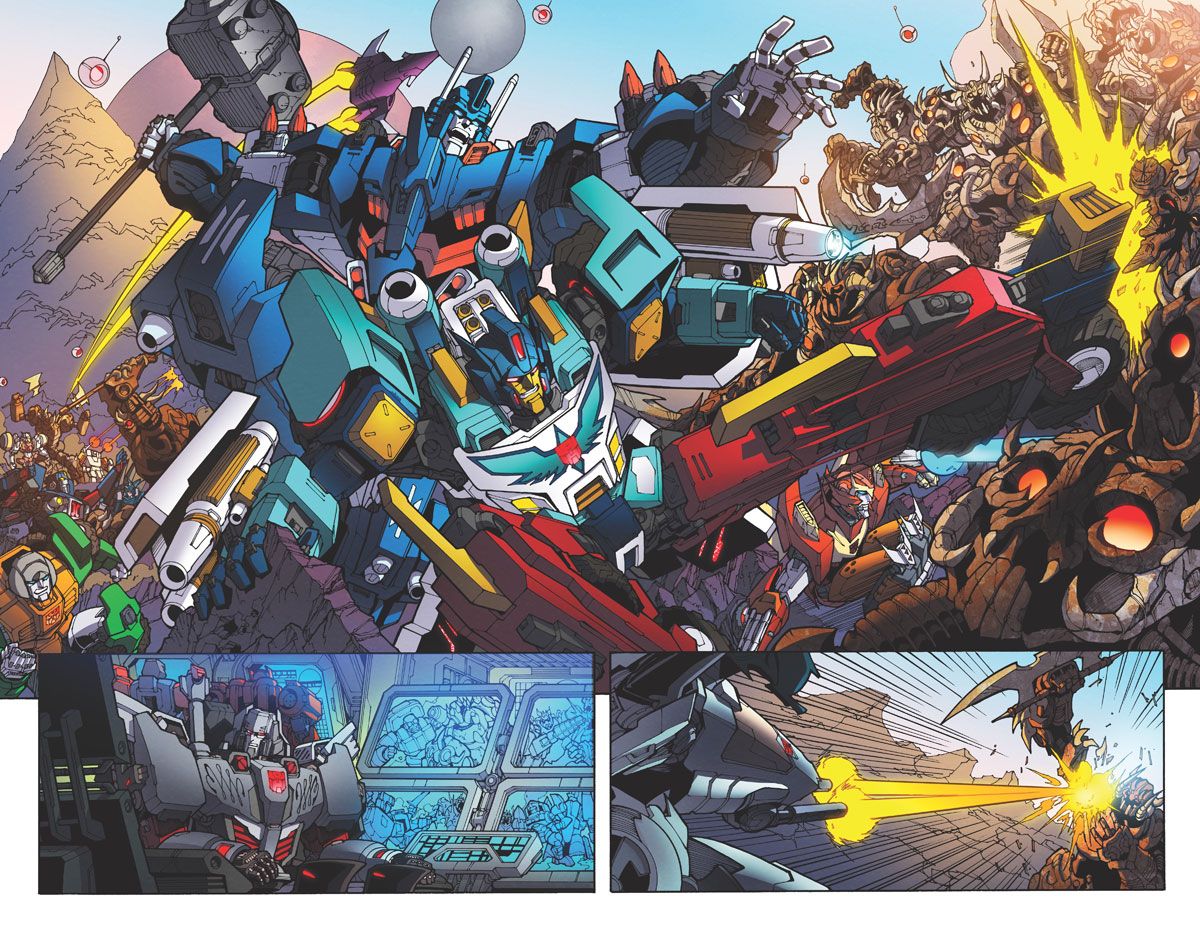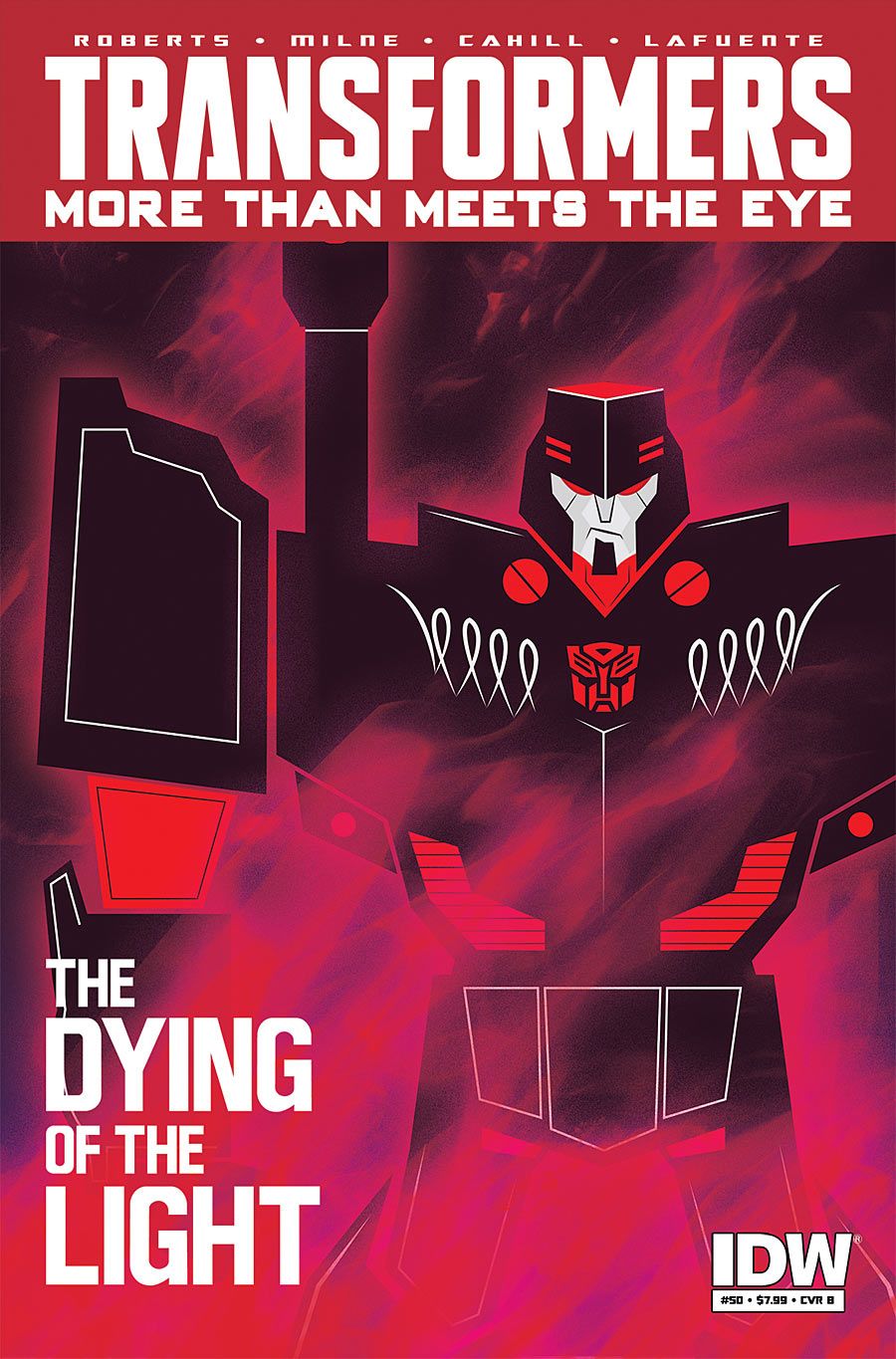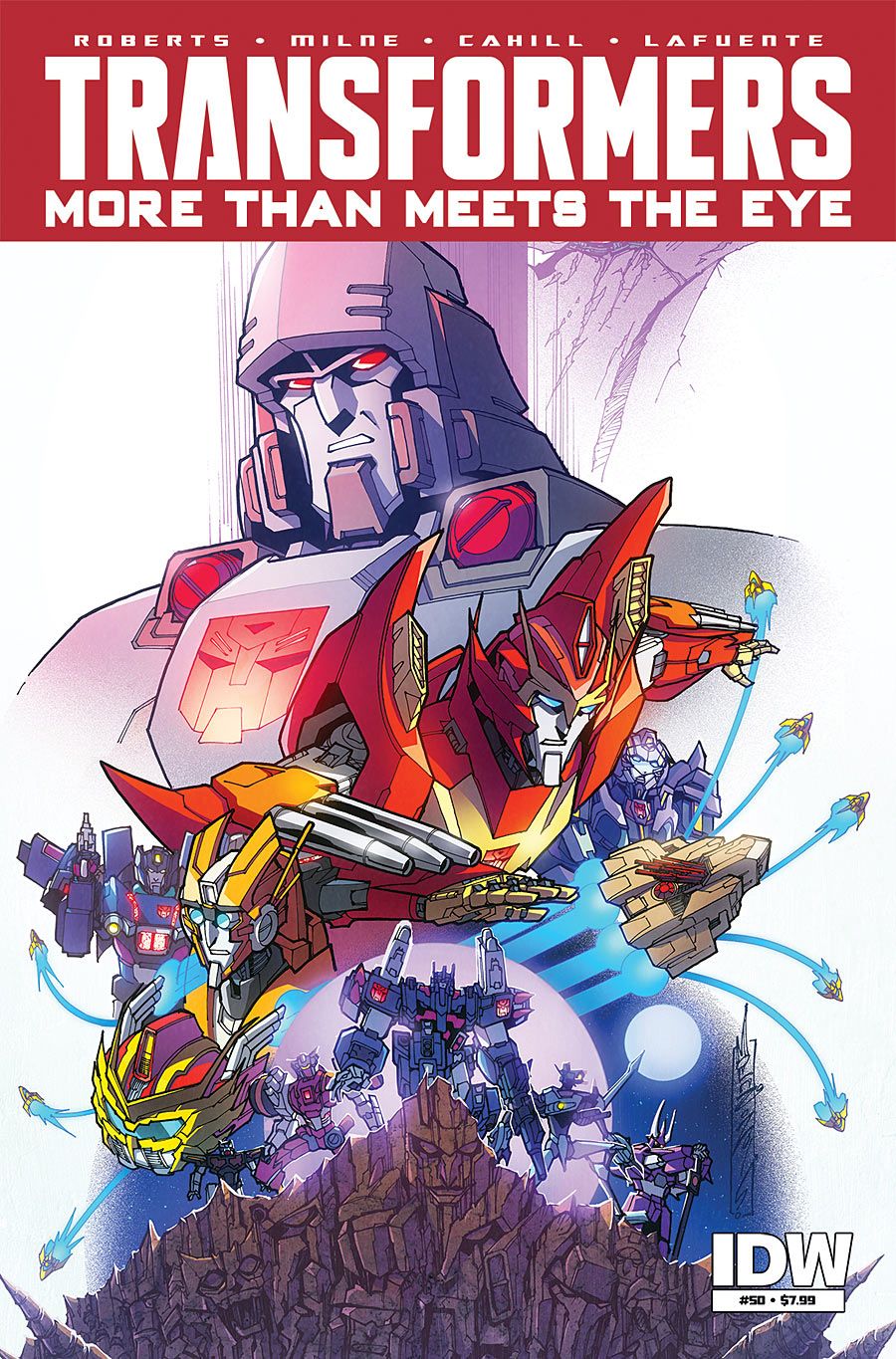Unless you've been reading IDW Publishing's "Transformers: All Hail Optimus" and "Transformers: More Than Meets The Eye" for the past 50 issues, you probably were unaware of a few things. For example, Megatron is a non-violent Autobot, Starscream leads the Decepticons, and Optimus Prime is attempting to annex Earth, whether its citizens like it or not.
And those are just a few of the changes brought to the Transformers Universe, all of which make perfect sense, as crazy as they may seem to fans of the classic cartoons and comics. Now, with both books hitting the 50 issue mark, writers John Barber and James Roberts, along with artists Andrew Griffith and Alex Milne, are kicking off stories designed, in part, to give new readers a place to jump on board.
RELATED: "Transformers" Bumblebee Spinoff Confirmed For 2018
Barber's "Transformers" -- now sporting the "All Hail Optimus" subtitle instead of "Robots in Disguise" -- hit the #50 watermark last month while Roberts' "More Than Meets The Eye" celebrates its 50th issue today. The former follows Optimus Prime's declaration that Earth is now part of the Cybertronian Council of Worlds, while "MTMTE" finds Megatron continuing to face his past mistakes including the Decepticon Justice Division. CBR News spoke with Barber and Robots about reaching fifty issues, current events, and what's in store as each title marches toward #100.
CBR News: First of all, congratulations on getting not one, but two different Transformers books to the 50-issue mark. That's no small feat these days. What is it about these characters that keeps inspiring creators like yourselves to work on them and readers to buy them?
John Barber: I think there were two fronts working in favor of the Transformers as a general idea. One was, with the toys, the actual mechanics of the things are so cool and fascinating. They're immediately engaging to a lot of people, like a puzzle, plus you have the vehicle and the robot modes to play with. It's just a cool toy.
On top of that, and more importantly to me, is the story that was built out of that was so huge and far-reaching and inspiring. I'd played with the original Diakron toys when they came out -- thanks to my friend when I was 7, Steve Pietraszek, who just contacted me yesterday for the first time in 30 years because he's reading the comics and he thought, "This can't be the same John Barber from kindergarten, can it?" He tracked me down which is amazingly cool!
When that comic -- the first issue in 1984, by Bill Mantlo, Ralph Macchio, Bob Budiansky and Frank Springer -- came out, seeing all those characters and the grandness of this metal world at war, and the warriors hurled to our world and continuing to battle. All of it was so exciting and intriguing.
Everything creators later added to the mythos -- Simon Furman and Flint Dille, to name a couple that I've gotten a chance to work with and know a little bit -- all of that expanded the world. I think the canvas presented in the comics and the animated movie and with the expanding toy line created so many possibilities of narratives and ways of looking at characters.
The Transformers are like us, but more so; bigger than life, like superheroes, but still with genuine heart. They're real people we can all relate to, and the fantastical elements makes them more real, easier to see yourself reflected in them.
James Roberts: I think John's right -- what's appealing is the combination of the universal and the intimate. I mean, fans talk about the Transformers Universe, and it's true -- the saga really does span all of time and space. Transformers has always been immensely ambitious in concept and execution, whether we're talking about Simon Furman's grand mythos (the idea of the Cybertronians' progenitor being creator of the universe and his nemesis being a threat to that universe) or the rich, densely-layered storylines that characterize the Marvel and IDW continuities.
At the same time, all this galaxy- and millennia-spanning space opera stuff is firmly rooted around a cast of characters who, at their best, are either immensely relatable or enjoyably larger-than-life. They're the lynchpins. They're your entry into this thrilling, sprawling universe where anything can happen. Creators past and present are attracted to the huge range of storytelling possibilities -- from grand canvas stuff to small-scale, character-driven dramas.
Historically, anniversary issues like this attempt to not only celebrate all the ones that came before, but also offer new readers a chance to jump on. Is that the case here?
Barber: Yeah, definitely. I mean, both of us, I think, have a tendency to build things up over time, but both of these are part one of a new story. I think "MTMTE" #50 does an amazing job of being a great place to enter the story and get hooked on what's happening -- if you're a new reader -- and also of building on every event we've seen since issue 1 for the rest of us.
Roberts: I remember talking to John a while back, and we'd both independently decided that it would be best if our issue 50s were the start of something new, as opposed to the conclusion to a long-running story. We want these milestone issues to pique new readers' interest and encourage those who for whatever reason have thus far been resistant to jump on board.
Barber: On "Transformers," artist Andrew Griffith and I -- who've been at this together since issue #1! -- start off with a big bang, a big action sequence that leads into the ramifications of what Optimus Prime does. It builds on what we've been doing, but it's definitely a point of specific change that's -- I think -- a reasonable place to come onboard. You can definitely catch up with who everybody is and what they're doing.
Roberts: Yeah, in "MTMTE" it''s a pretty simple pitch: some time ago, Megatron defected to the Autobots. In response, the Decepticon Justice Division -- a group of phenomenally dangerous fanatics who refuse the let the dream die -- have mustered an army and have been chasing Megatron, hell-bent on revenge. Now, they're about to catch up with him.
John, the "All Hail Optimus" arc will focus on Optimus' decision to incorporate Earth into the Cybertronian Council of Worlds. How do the others respond to that move, and how do the leaders of the world respond to Optimus' annexation?
Barber: Optimus decides to pull Earth into the cosmic community, whether it wants to be there or not. On the way, he wants to fix all the things he sees wrong with Earth.
Optimus has a lot of followers -- especially from Cybertron's recently-rediscovered colonies -- who believe him to be more than just a Cybertronian, who believe him to be one of the original thirteen Primes. That's something he's uncomfortable with, but now he's using it to his advantage.
The reactions everybody else has, that's the crux of the story, really. Starscream, who's in command of Cybertron -- Optimus Prime has accused him of trying to start an empire, and now, here's Prime, going out there and annexing places. Starscream, not without reason, sees this as a little hypocritical. And the Council itself, and Windblade -- this isn't an authority Optimus actually holds.
And Earth, woooo. Yeah, people aren't going to take kindly to this. Things have not gone right with Cybertronians before, and here's one saying people aren't doing a good job ruling Earth. There's going to be a big response, both in this story arc, and coming out of it.
James, as you mentioned, in "The Dying of the Light," you have a Megatron in search of redemption facing his greatest failure, the Decepticon Justice Division. Has his new outlook on life changed how he deals with this situation?
Roberts: You're right to describe the DJD as his greatest failure. He created them to hunt down and kill Decepticons -- people on his own side who had gone AWOL, or shown themselves to be cowards, or given in to their conscience, or defected. And in a way -- certainly as the DJD are concerned -- he's guilty of all those crimes.
From his new vantage point as an Autobot, he considers the DJD to be the epitome of everything that went wrong with the Decepticon Cause -- and indeed with his own life. The DJD represent the worst of all things. They kill to spread fear. They kill because they like it. As far as Megatron is concerned, they are beyond justification. And they're heading in his direction.
As for how he deals with the situation, at the end of issue #49 he took his new outlook on life to the next level and publicly renounced violence. He said he would not personally harm another creature, regardless of the provocation. He may not be an out-and-out pacifist -- he doesn't use the word -- but he won't raise a hand against anyone ever again. So, yeah, bad timing.
What can you both tell us about these books as they continue on into 2016?
Barber: Right after these stories, we have a tale called "Titan Returns" that James and I are writing with Mairghread Scott (who's writing the "Till All Are One" series). After that, there's something very exciting we've been talking about internally, but we're not ready to unveil to the public yet.
Roberts: "The Dying of the Light" is a six-parter, the biggest "MTMTE" story to date. We end up in a very different place to where we started.
For a lot of people, Transformers will always boil down to what's going on with Optimus Prime, Megatron and their respective followers. I think it's interesting that you have them both dealing with redemption in various ways. Was that by design or something that came naturally from the stories you wanted to tell?
Barber:I think we both came at these comics as post-war comics. I think even in the most justified war, terrible, unconscionable things are done. Coming out of a war, I think a lot of those people who fought will look for a return to their old life, but the circumstances behind the war for Cybertron prevent that from happening. They're stuck facing, and re-facing, the war.
Roberts: In the first "season" of both books, John and I had fun telling stories in the absence of The Big Two -- the war was over, Optimus and Megatron had been purposefully removed from the books, and we were exploring what happened in that vacuum. For the last couple of years, the two characters have been at the forefront and I think we've both taken the opportunity to give them stories that are immensely personal to them -- in the sense that the events shaping them, and the events they're helping to shape, strike at the heart of their very nature. Because oddly enough, given their status as characters, relatively few TF stories delve deeply into the "why" of Megatron and Optimus.
In a sense, Megatron and Optimus are acting against type. Megatron, certainly, is exploring entirely uncharted personal territory and his really is a quest for redemption. By his actions, however justified (in his eyes), Optimus is doing something un-Optimus-like. There's a pleasing symmetry there, and I'm going to lie and say John and I mapped this out four years ago.
Speaking of maps, these books are absolutely packed with characters. Do you each keep storyline maps or lists of who's doing what and where?
Barber: I wish I was that organized. It's hard to keep track, and it's hard to get page-time for everybody. It's funny -- Andrew always wants to draw new characters, which I get. Drawing the same guys over and over again is less fun, I think, than writing the same guys over and over again. Writing it, you get to know them more, you see more through their eyes. Drawing them, I bet you get mad at whatever random bolt you drew in issue #11 still has to get drawn every month by issue 50.
I try to keep track of where everybody's going, what their arc is, and where they wind up at the end of the story.
Roberts: When we started on the books we divvied up -- is that a British word? Divvied? We carved up the main 300-ish Generation One characters -- the Autobots and Decepticons from the '80s, mainly -- and worked out who was on Cybertron for John's book and who was in space for mine. Aside from some playground-style swaps between seasons, we've pretty much stuck to those lists.
"MTMTE" is an ensemble book with a big cast -- even by those standards -- and it's a challenge to give the dozen or so main characters a chance to shine. It's like spinning plates. But because a lot of the action takes place on board the Lost Light, I don't have to worry too much about who's where at any particular moment. Anyway, in "The Dying of the Light," everyone gets some love and attention.
When you both set out to launch these books, were there specific ways you wanted to steer the Transformers in new directions? How do you think you've done with that, and have those goals chanced over the years?
Barber: I just wanted to tell a good story, one that I wanted to see. I think our initial approach probably came from where we came at Transformers. I was a big Transformers fan, but it was something that would sort of come in and out of my life over the years, in different forms. I had characters I liked and toys I was nostalgic for, but I was probably more in tune with the big elements, the premise, of Transformers, where I think James was probably more into the characters and developing further lore and backstory.
Roberts: Yeah, telling a fun, entertaining story -- that was the simple aim, then and now. "Tell a good story featuring Transformers," rather than "tell a good Transformers story," if that makes sense. That said, I wanted to break new ground, Transformers-wise, by writing an ensemble book, which hadn't really been done before. You tended to have a core cast, definitely, but they weren't portrayed as a gang in the way a starship crew is.
In a similar vein, I wanted to ramp up the banter and the humor and the -- God, I don't want to say anything that involves the word "wacky." I wanted to tell offbeat stories with a weird science fiction bent. And, as John says, I was keen to flesh out the world beyond the war -- Cybertronian society, customs, relationships, stigmas and so on.
Barber: I was interested in the idea of the war being over, and how the society and the group as a whole would work, post-war. From there, I focused in on a few characters, which grew over the years into a larger cast. That in itself was a new direction, but one intrinsically tied to what I think of as "what Transformers is about." If that makes sense.
Roberts: As for whether I've achieved my goals, I think so, yeah. I'd say "MTMTE" is deceptively dark, though -- maybe darker than I intended. It's always got that surface-level jokiness, with the characters bouncing off each other, but there's serious stuff swirling around underneath. Actually, thinking about it, the book has evolved into a story about "damaged" people -- quotation marks essential. No one on board the Lost Light is without flaws, and they sort of stumble through life half-heartedly doing their best and screwing up/succeeding in equal measure. Like the rest of us.
Transformers comics might seem like a tough nut to crack for new readers. I found the books fairly easy to hop onto, but how do you convey that to potential new readers?
Barber: I always think about new readers, or the problems readers might have. It's sometimes difficult to keep track of the characters, for some people. There's a mental block that makes it harder for some people to differentiate Transformers, as opposed to human characters. And the opposite is true, too -- there's people that can recognize a Cybertronian by his or her ankle, but have trouble telling any superheroes apart; nothing wrong with either, just different types of people. But I think once you get into these stories, it becomes easier to see they're just people. Big, metal people, but people all the same.
I honestly think more people think they'll have a problem reading Transformers than actually do have that problem when they try.
Roberts: I would definitely echo that. So many people, when they take the plunge, say that they were worrying about nothing -- you don't need to know 20 years of backstory, or be able to tell your Combaticons from your Constructicons. Basically, if you go in knowing that Autobots are usually the good guys, and Decepticons are usually the bad guys, and their endless war has now ended, blurring the lines, that's all you need.
The issue 50s definitely invite new readers in, but for the curious, the alternative is to start with issue 1 of both titles (John's "Transformers" was subtitled "Robots In Disguise" then), or the preceding one-shot, "Death of Optimus Prime." Those issues were precision-engineered to be jumping on points requiring no background knowledge whatsoever.
We're both proud of the books, and we're really keen that non-Transformers fans give them a go. You won't know what you're missing otherwise!
To get in on the giant robot action, check out "Transformers" by John Barber and Andrew Griffith as well as "Transformers: More Than Meets the Eye" by James Roberts and Alex Milne each month from IDW Publishing.

